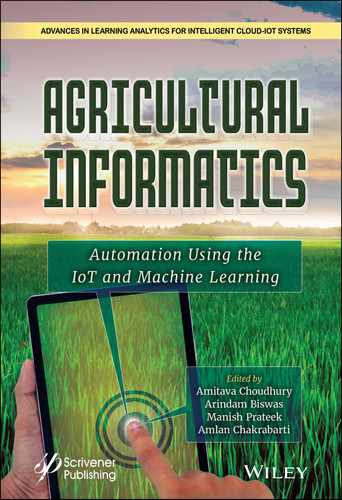12
Plane Region Step Farming, Animal and Pest Attack Control Using Internet of Things
Sahadev Roy1*, Kaushal Mukherjee2† and Arindam Biswas3
1Department of ECE, NIT Arunachal Pradesh, Yupia, India
2Department of Physics, The University of Burdwan, Burdwan, India
3School of Mines and Metallurgy, Kazi Nazrul University, Asansole, India
Abstract
The cost of agriculture in plane region grows rapidly in recent years due to less rainfall, animal and pest attack. In this paper, we present an advance step farming method applied for the plane region with the help of the IoT. The step farming done in hilly areas in terms to increase production rate, less maintenance, etc in the paddy field. By considering step farming in the plane region, we can increase the production of the crop to the next level. Moreover, by applying the network of various sensors like humidity, temperature, rain detection sensor, water level detection sensor, an ultrasonic sensor for detecting animals invading to the field, etc. These sensors are connected to the internet by using IoT network for closed monitoring. By using the IoT, we can maintain proper scheduling of the irrigation as per the weather information of the field area. We are using cayenne drag and drop IoT builder to design sensor networks for the proposed agriculture farm to observe and control various sensors and actuators from anywhere in the world through a laptop, desktop, and Android Smartphone. Here we present a prototype of a irrigation field and validated our model in the real world.
Keywords: Agriculture, internet of things, sensor network, irrigation, pest and animal attack control
12.1 Introduction
Recent study reveals that the worldwide population is about to reach 10 billion within 2050 [1]. To feed this substantial population, the agriculture farm is bounded to implement the IoT-based smart farming. In crop growing, the IoT has brought the utmost impact [2]. IoT is eliminating challenges like climatic changes, extreme weather conditions, environmental impact and improves the supporting the entire agriculture system by observing the field in real-time. IoT-based smart farming is helping us to meet the demand for required food. The help of the IoT in agriculture has not only saved the time of the farmers but has also reduced the excessive use of resources such as electricity, fertilizer and water. Agriculture is no doubt the largest sustenance providers in India. It also gives a very vital contribution in GDP (Gross Domestic Product). But the farmers who are known as the backbone of India are subjected to many personal as well as field-related problems. So we need to advance agriculture system and modify current farm structure so that farmers get more yield and they can easily manipulate the crop and observe each and every activity from home itself without a physical presence in the farm [3]. Due to this, they will get more relief from mental stress as well as stress from work. Also, by using an advanced technique, we can save rain water for the next crop, when the water scarcity problem arises [4]. This automation is possible by using the internet of things which is the network of various sensors, actuators and physical devices which are well installed on the advanced farm structure mentioned above [5]. All the sensor devices are connected to internet and user can access data from anywhere in the world.
Internet plays the main role in observation of the digital data from every part of the world that is available electronically. The world is now working based on the internet. With the help of internet connectivity people can monitor their work from anywhere in the world from their PCs or Smartphones [6]. Internet service help is the collection and exchange of digital data around the globe. The achieved data can be compared with the specific area location and earlier data analysis or with any predefined model. The data achieved from the sensor can be monitored and managed from any part of the world with the help of IoT, where the internet service is accessible. In this way, IoT helps in the enhancement of effectiveness, accurateness and facilitate the nation to attain an enormous tip in this digital world [7]. Although, IoT is totally a fresh concept, it becomes an attractive subject in several industries because of its most up-to-date trending technology. The foremost theory of IoT was proposed by Kevin Ashton, in the early 2000s [8]. According to Verizon, IoT has definitely risen above its early life and is in good health to achieve some definite momentum in the world of digital system. Verizon issued in their “State of the Market” that, nearly 1.2 billion various smart devices are using the IoT services and it will be increased up to 5.4 billion within 2020 [9].
As the population grows, it looks like it will reach a billion by 2050, from this point of view of population growth, according to the United Nations Food and Agricultural Organization, we need to increase food production up to 60%, to feed this growing population.
IoT is transforming the farming sector by assisting the farmers to tackle their huge challenges. The organization must overcome rising water shortage, limited land resources, tricky-to-manage expenses while addressing the increasing needs of world’s population which is predicted to increase about 70% before 2050 [10].
New, innovative IoT technologies solve these problems and increase the quality, quantity, productivity and price-effectiveness of crop production. For example, modern wide as well as rural farms could utilize IoT that dynamically control sensors, capable of detecting moisture levels, seed production as well as animal feed rate, remotely monitor and control their intelligent embedded excavators and irrigation infrastructure, and use robotics-based analysis to efficiently evaluate functional information coupled with data from external parties, like weather systems, to have different insights, as well as to strengthen judgment-making.
The population of the world is increasing at a rapid pace but the sum of wealth or resource does not prosper as well as that. There is a certain amount of money in our possession and we need to manage our available resources properly. The price of fertilizer, electricity is increasing, but the amount of irrigation is set, so farmers need to make wise use of their resources in farming. If both the infield and the field-to-shelf monitoring management are handled properly, crop wastage can be minimized to some extent.
Everybody in this world has to face problems in their lives, such as deadline pressure, lack of knowledge available, time and distance challenges etc. that can be solved with the help of IoT.
This is the current generation where the internet is a daily need of people, which the development of agriculture without internet is not feasible in any way. Modern agricultural work rapidly became an information-intensive industry, where farmers desperately need to collect data from various sources or devices such as sensors, farming machinery, meteorological tendering, etc., and analyze the information obtained from all these objects in order to cultivate crops efficiently. Hence these processes are required to train the farmers which is turn would increase the rate of crop production. The initiatives deals with a number of issues such as environmental impact, food safety, labor welfare, plants and animals safety and security, existence of regional market, etc. A portable sensor network is a custom transducer system which provides a surveillance system for controlling and capturing parameters at various locations. A WSN framework integrates a gateway by directly providing mobile connectivity into the wired network and centralized nodes [11]. The wireless device may be chosen based on the program’s specifications.
Step farming is the process of cutting steps or flats on the sidewalls of mountains for cultivation. Cultivation through step farming is implemented on the hilly regions which can be controlled by the farmers without using any kind of technical features. Farmers get experienced from a lot of emotional stress and therefore more physical labor because of this. Although despite implementation of internet of things to track soil, water and weather conditions in this field, we’re not going to get that much of the output that we’re getting done in the plane zone. Step farming can be divided into two categories namely plane region step farming and hilly region step farming. One example of step farming is the cultivation of paddy on the mountains of Asia. The main objective of this research work is to discuss the plane region step farming procedure and how animal as well as pest attacks can be controlled with the help of IoT. Mountainous rice paddies in Asia are the most popular examples, where generations of farmers have held the same parcels of land.
12.1.1 Possible Various Applications in Agriculture
Horticulture: Even without weather monitoring, we can use wireless sensors to observe various aspects like soil temperature, air moisture, solar radiation, greenhouse temperature, humidity levels, rainfall intensity, etc. We can turn from the different information gathered from the sensors whenever we need grain maintenance. This is one of saving time as well as money.
Livestock: From identifying animals to their footprints, Radio-Frequency Identification (RFID) is quite fast to find statistics of each species, including their birth as well as selling information, etc.
Security: Agriculture is the economic backbone of developing countries therefore, security in agricultural sector is essential. As can be seen, with the aid of IoT, the entire cycle from production of agricultural products to market sales can be tracked and managed completely.
Water management: It is seen that after we use water, we do not turn off the faucet properly and water continues to flow from the faucet. So in many areas sensors are installed in the faucet. When we don’t use water from the faucet, the water from the faucet will stop flowing automatically, thus wasting water.
It’s seen that we don’t shut off the faucet properly after the use of water and the water continues to flow from the faucet. Thus sensors are mounted in the faucet in many places to avoid waste of water. If we don’t use water from the faucet, the water from the faucet will immediately stop flowing, thereby reduces the water wastage. It is therefore obvious that with the aid of IoT, we can retain water in various ways. The same idea can also be put into action with the agricultural fields, with the help of IoT the need for water for the crops at what time and in what amount can be remotely controlled which in turn reduces water wastage.
Health application: Monitoring has a unique function in health issues. IoT is mainly a network system that consists of a network of surrounding life support devices. WSN sensor plays a significant role in integrated patient monitoring, disability tracking, diagnosis and rehabilitation, proper drug distribution and several facts such as physician and patient monitoring in the hospital.
Agricultural sector: Use the wireless sensor network allows farmers to produce crops in tricky condition. Most crops, for example, are rain-fed but agriculture in arid areas disrupts certain crops, but the use of this network determines how much irrigation is required. As a result, it will become reasonably profitable in a fair way and sufficient quantity in agriculture. Area monitoring: Sensor nodes are set up in an area where certain events are observed. These nodes then monitor the events such as its pressure, temperature etc., and then generates a report, based on that Administration with the help of local people takes necessary action. Industrial monitoring: The use of these sensors has become quite an important part of the industrial sectors. These sensors act as an indicator of the industry i.e. if any part of a large device is faulty so that we do not need to inspect the whole part, only by examining that part we can know which part of the machineries is defective or damaged. This saves us both time and money. Environmental monitoring: Earth Science research relies on a variety of studies on the environment. As can be seen in several cities such as Stockholm, London, etc., to determine how dangerous the gas concentration is for the citizens of that region. As a result, it is possible to monitor the air pollution in the area and maintain civic awareness. Also other environmental parameters such as forest fires, landslides, etc. can be sensed.

Figure 12.1 Architecture of sensor node.
The design of the sensor node is comprised of several tracking points called sensor nodes, including transducers, microcomputers, transmitters and receivers and power source; all of which are compact, lightweight and versatile as shown in Figure 12.1. Transducer produces electrical signals on the basis of perceived physical effects and condition. The microcomputer analyses the sensor data, and stores it. The transceiver collects instructions from a central database and sends information on to that computer. For each sensor node the power is extracted from a battery.
12.1.2 Cayenne IoT Builder
Cayenne offers the first function-built IoT architecture planned to meet today’s unique technological world requirements [12]. Cayenne has the protection and functionality to manage millions of regular operations as the leading IoT platform [13]. In a fraction of the time of other approaches, one can deliver effective, new IoT solutions for smart agriculture with Cayenne.
12.2 Proposed Work
12.2.1 Design of Agro Farm Structure
In agriculture, to perform more effective farming we need to cut the plane surface into series of the successively step-like structure as shown in Figures 12.2 and 12.3. These types of farming are commonly found in hilly or mountainous terrain [14].
But in this paper, we have designed this type of model for the plane region to obtain greater production with the full support of sensor network control through the internet of things.
Here, the designed farm structure is worked as follows. During the rainy season, the quantity of water available is more, but the crop required less quantity of water. Excess water must be transferred from farm 1 to farm 2 and farm 2 to farm 3 and so on. Here the main point is an election of crop according to the water required at the different step of the farm. According to that crop will be placed and excess water at the end of all is stored in the water tank reservoir for the future need of water. During winter and summer, the water collected during rainy season as well as from external source is to be utilized for the feed purpose by continuously monitoring the moisture level of the soil.

Figure 12.2 Side view of the designed agro farm structure for the Plane region.
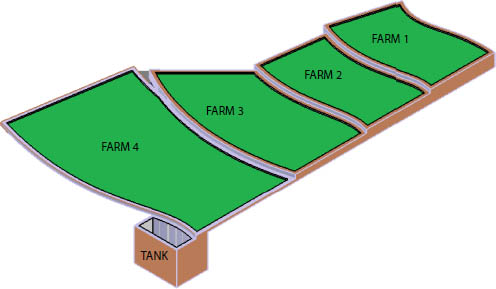
Figure 12.3 Full view of the designed agro farm structure for the Plane region.
The water reservoir also receives water from the external source such as a canal, waste water from the village and small drainage system. The size of the water reservoir depends on the farmers land. If the land is more storage tank is required and vice versa.
Currently, step farming procedure is only implemented in the mountainous regions which are controlled by the farmers with little or no technical feature being used. Farmers get experienced from a lot of emotional stress and therefore more physical labor because of this [15]. Despite implementation of internet of things to track soil, water and weather conditions in this field, we’re not going to get that much of the output that we’re getting done in the plane zone. Some advantages of step farming over in plane regions in contrast with hilly regions have been tabulated in Table 12.1.
Table 12.1 Advantage of step farming in-plane region versus hilly region.
| Sl. No. | For plane region | For hilly region |
| 1. | The in-plane region, we can expect more production because of large step size. | In the hilly region, we can expect less production as compared to the plane region because of small step size. |
| 2. | Big area with big step size. | Small area with small step size. |
| 3. | The cost of digging to make step is same as that of the hilly area because the no of the step is less and depth is also small. | The cost of digging is nearly same because we have to create more steps with more depth than plane region. |
| 4. | Easy maintenance using sensor network and can be controlled and observeeffectively by using internet of things. | Hard to implement because of the unavailability of the network problem so, create some hindrance between sensor and signal. |
| 5. | By using rainwater harvesting, we can increase the production rate. Also, by using proper irrigation using IoT, we can take crops in all the three season i.e., summer, winter, and rainy. | In this reason also, we can increase production rate by using rainwater harvesting, but the problem is the storage of water. If we store water at the bottom, then more force is required by the motor to pull water upward so, chances of the burning of the motor. |
12.3 Irrigation Methodology
Irrigation takes a really crucial part in the expansion of crop production. Production of food relies significantly on the irrigation quality supplied to the crops. We can just get 55% of crop production from irrigated fields, so the irrigation method needs to be stressed more to solve water scarcity problems [16].
The irrigation network for the farming field is shown in Figure 12.4.
Selection of plant species is according to the water requirement in that area. Plant breeding and plant species selection play a very important role to increase the productivity of the available water in the respective region.
The way in which planting is done in the field is a very considerable factor to capture sufficient solar energy from the sun for photosynthesis and for better evaporation process. It mainly employs two types of planting pattern practices, i.e. plant density and row spacing.

Figure 12.4 The structure of farm by applying suitable irrigation network of pipes.
Selection of optimum months and dates for good germination and placement of seeds in the optimum moisture zone is a necessary and optimum condition for good root growth and root penetration and take maximum nutrient content from the soil [17].
We need to remove weeds from the crop because weeds can challenge with the crop by taking light, soil nutrient and water. So by utilizing effective weed control technology, we can increase water use efficiency of the plants.
Several hybrid varieties of the crops are available in the market which is pest resistant and certain diseases which are common to the area so, efficient crop and water management includes the rational use of chemical pesticides [18]. We can increase water use efficiency by the managing crop in the field.
12.3.1 Irrigation Scheduling
It is the processes which suggest to the farmer in deciding the time to start irrigate and specify the quantity of water needed for irrigation. Proper scheduling is necessary to use water effectively and proper manner. Irrigation scheduling gives the estimated water requirement of the crop [19].
By regularly monitoring the water in soil and crop development condition and future forecasting of the need of water by the crop based on the daily data obtained by the sensor (as shown in Table 12.2), efficient irrigation is possible [20].
Table 12.2 Water requirement (mm) of different crops.
| Crop | Water requirement (mm) |
| Rice | 900–2,500 |
| Wheat | 450–650 |
| Maize | 500–800 |
| Sugarcane | 1,500–2,500 |
| Groundnut | 500–700 |
| Cotton | 700–1,300 |
| Soya bean | 450–700 |
| Tobacco | 400–600 |
12.3.2 Two Critical Circumstances Farmers Often Face
- Under-irrigation: In summer and winter, a limited quantity of water is available so scarcity of water may arise. To get a ride from this we need to feed water to the crop from the external source.
- Over-irrigation: In the rainy season, more water is available, so crop always submerged in the water so there is a chance of damage to the crop. So, to move excess water from that field here, we used a solenoid valve to pass water from field to reservoir.
12.3.3 Irrigation Indices
Irrigation technique is based on the observation of plant–soil–water–atmospheric calamities. The radiation received from the sun fall directly on the leaf during daylight which is utilized for transpiration. The remaining energy is used to heat the plant’s leaf tissue and the air surrounded by them. So we need to periodically check the temperature and according to that moisture level is maintained. The status of water can be visualized by the color of leaves and curved leaves etc. Also, we find the requirement of water by measuring leaf water content and leaf water potential.
We can calculate the amount of water required for the irrigation which is calculated as follows:
Water requirement per Irrigation = (DRZ(MCAI − MCBI))/IE
Where,
DRZ—depth of root zone
MCAI—soil moisture content after irrigation
MCBI—soil moisture content before irrigation
IE—Irrigation Efficiency.
12.4 Sensor Connection Using Internet of Things
Figure 12.5 shows the sensor interconnection for fields 1 and 2 using the internet. We use cayenne as fast drag and drop IoT builder platform to control and manipulate the entire sensor network which is applied at the Smartphone Tablet Admin farm. The things were easy by using this latest IoT project builder which consists of an androidapp for the Smartphone. The sensor like water level sensor measuring the water level of tank, rain drop sensor for alerting if there any raining or not, DHT22 sensor measures temperature and humidity of the field environment, soil moisture sensor measure the moisture level of the soil according to which the actuator like motor start or stop by feeding control signal to relay to activate. The solenoid valve is used to draw excess water from the field. The entire sensor feeds their value to the cayenne server and can be accessible via Smartphone and laptop. A flowchart that illustrates the whole operation of the proposed system is shown in Figure 12.6.
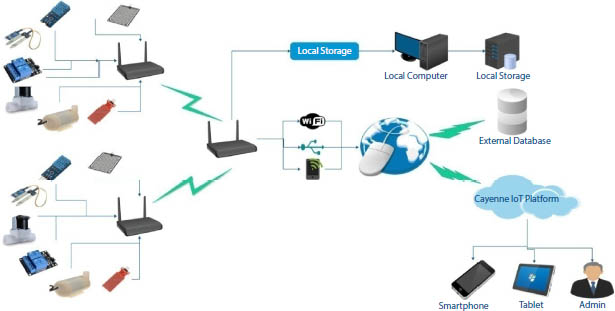
Figure 12.5 Sensor interconnection through the Internet of Things.
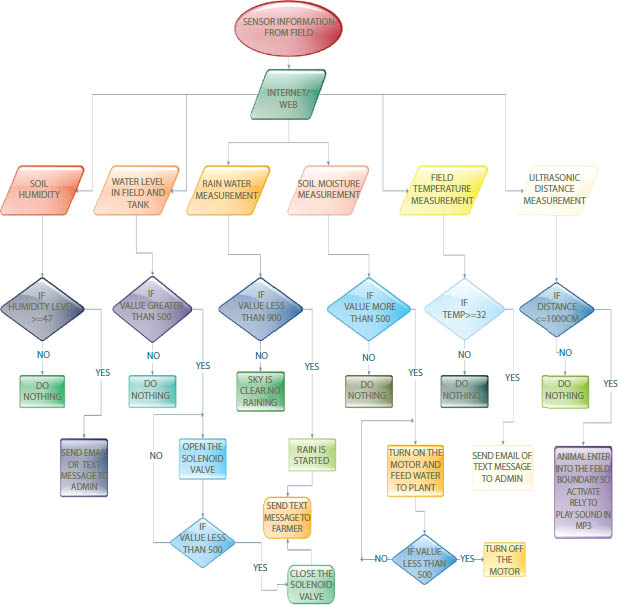
Figure 12.6 A flowchart which describes the complete operation of the proposed system.
12.4.1 Animal Attack Control
Figure 12.7 illustrates the placement of the various sensors to avoid the animal attack in the field site. We use anultrasonic sensor which continuously giving fixed value by sending trigger pulses and obtaining echoes generated by striking the obstacle. If any wild animal invading through this path, then sensor value will suddenly change which will send a trigger signal to the Arduino and then Arduino will activate mp3 sound to threaten the invader animal. So that wild animal will leave the field and we are able to save our crop from destruction.
But to carry out the above process, this proposed model does not include any of the human physical appearance and the entire process can be managed remotely via IoT.

Figure 12.7 Placement of ultrasonic sensor with the Arduino to avoid the animal attack.
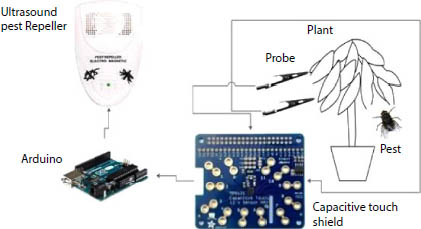
Figure 12.8 The probe connection of capacitive touch shield with Arduino to trigger ultrasound device to avoid pest attack.
12.4.2 Pest Attack Control
Pest is the main factor which is responsible for destroying the growth of the crop. Due to excessive use of pesticides, several deaths of consumers are happening. It contains toxic chemicals which directly enter our digestive system and cause various health related issues [21]. By using capacitive touch shield as illustrated in Figure 12.8, if any insect or pest comes in contact with leaves of the crop, it triggers a signal that will be generated which will activate the ultrasonic sound generator. Due to the low frequency (irritating to the small insect or pest) of ultrasound, the entire pest will stay away from the given area and thus we get rid of these things. So we can save crop as well as save human health-related issues.
12.4.3 DHT 11 Humidity & Temperature Sensor
Every DHT11 feature in the laboratory is specifically calibrated, which is extremely precise for calibration of the humidity [22]. The calibration coefficients are installed in the OTP storage as programs which are used in the internal signal detection process of the sensor. The serial interface with single-wire ensures device installation smooth and efficient.
12.4.4 Rain Sensor Module
The module rain sensor is a simple tool for measuring rain. This can also be used as switch whenever a drop of water passes via the rainy board and also to calculate the severity of the rainfall [23]. The system includes a rainfall panel and the separate control panel for more efficiency, an LED power detector and a potentiometer variable tolerance.
12.4.5 Soil Moisture Sensor
The sensor for soil moisture determines the moisture content in the soil. Measurement moisture in cultivation is crucial for helping farmers monitor their irrigation systems quite effectively [24]. Not only are farmers normally able to use less water to grow a crop however they are able to improve productivity and crop quality through improved soil moisture management during crucial plant growth phases.
12.5 Placement of Sensor in the Field
Netsim Simulation of the Architecture
We use NetSim network simulator to analyze the packet send by the various sensor which is placed in the field.
The graph of packet count versus various links ID is as shown in Figure 12.9 which is obtained from Table 12.3. From this, we get exact idea about how much information loss and transmitted to the cloud using various sensor places in the field.
All the values which are given by the sensor connected to the Arduino UNO, will be displayed by the cayenne dashboard. Cayenne dashboard can be observed on the desktop (see Figure 12.10) as well as android app (see Figure 12.11).

Figure 12.9 Screenshot of the various sensors placed at the field site by considering field size as 50 mm * 50 mm.
Table 12.3 The graph of packet count versus various links ID.
| Link Id | Packets transmitted | Error packets | Collided packets | Bytes transmitted (Bytes) | Payload transmitted (Bytes) | Overhead transmitted (Bytes) |
| 1 | 11,543 | 2 | 0 | 890,322 | 576,682 | 517,150 |
| 2 | 11,543 | 1 | 0 | 893,562 | 576,732 | 316,830 |
| 3 | 11,001 | 2 | 0 | 1,122,792 | 516,650 | 606,142 |
| 4 | 22,011 | 13 | 0 | 1,420,102 | 516,650 | 903,452 |
| 5 | 112,535 | 0 | 52,766 | 3,491,899 | 517,150 | 2,974,749 |
- A. Dashboard Snapshot of the Sensor Value in Desktop as Shown in Figure 12.10.
- B. Dashboard Snapshot of the Sensor Value in the Android App as Shown in Figure 12.11.
If any value of the sensor is exceeded beyond its threshold value decided by the user, then according to the threshold value, trigger is generated.
- By sending email to the admin mailbox
- By sending text message to the admin mobile number
- By sending control trigger pulse to the respective actuator by using relay circuitry.
The hardware snapshot under working condition of the sensor as shown in the Figure 12.12.
Smart Farming using IoT is a hi-tech and effective way of doing agriculture in a sustainable way. Collecting data and monitoring for air humidity, air temperature, sunlight intensity and soil moisture, across multiple fields will definitely improve efficiency of water usage and crop yield of large as well as local farms. Low cost sensors, data insights and IoT platforms will enable this increase in efficiency and production. Farmers can imagine production levels in real time and remotely to accelerate different decision making process. Precisely tracking production rates by field over a certain time allows for comprehensive predicting of future crop yield. Farmers can monitor multiple fields in several locations from any internet enable devices. Decisions can be made in real-time and from anywhere. Another advantage of using IoT is that farming equipment can be monitored and utilized according to labor effectiveness and production rates. Sensors are placed inside and outside of the agriculture fields. The entire IoT network is made up of sensors that can detect accurate weather conditions very accurately. Climate plays a very important role for the quality and quantity of the crop production. By using IoT solutions one can know the actual weather conditions. These sensors network monitors the real-time condition of the crops and try to compensate the different requirements which eventually increase the productivity.

Figure 12.10 Dashboard snapshot of the sensor value in desktop.
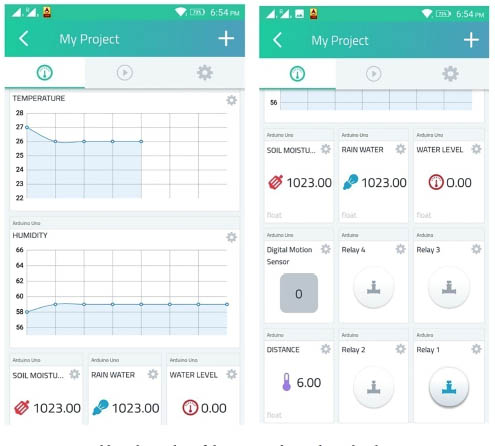
Figure 12.11 Dashboard snapshot of the sensor value in the android app.
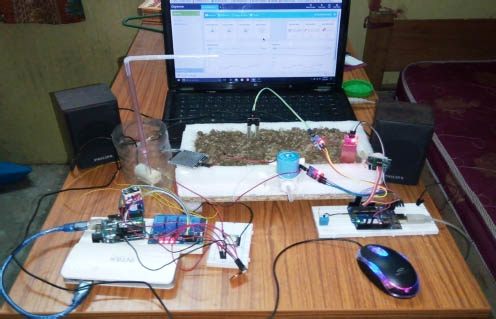
Figure 12.12 Hardware snapshot of proposed system under working condition.
12.6 Conclusion
Optimized crop treatment such as watering, pesticide application, accurate planting, and harvesting directly affects the crop production rates. By using organized fashion of field structure and proper irrigation scheduling and providing them the early prediction of weather condition on their mobile directly, may save thousands of life. Now, by this technique farmers are able to produce crops in all three season effectively and losses will be minimized. So death toll ultimately decreased. For the pest control, we need to use ultrasound of various frequency which. When any pest interacts with any part of the plant, then by using capacitive touch shield, we can detect the presence of pest so an alert signal is generated by the ultrasound generator. For the supply of constant and continuous energy to the sensor, we need to set up a solar cell powered battery in the field. To reduce the consumption of the battery, we need to set up some logic to activate the sensor network at a particular time and other time, the sensor network remains idle. Incorporation of small exhaust fan as a heat sink to protect the sensor devices or drive circuitry from the excess heat of the sun so, the age of the sensor devices and circuitry will increase. The IoT enable Plane region step farming, animal and pest attack control a truly enhanced crop production rate.
References
1. Béné, C., Barange, M., Subasinghe, R., Pinstrup-Andersen, P., Merino, G., Hemre, G.I., Williams, M., Feeding 9 billion by 2050—Putting fish back on the menu. Food Secur., 7, 2, 261–274, 2015.
2. Khanna, A. and Kaur, S., Evolution of Internet of Things (IoT) and its significant impact in the field of Precision Agriculture. Comput. Electron. Agric., 157, 218–231, 2019.
3. Rigg, J., Salamanca, A., Phongsiri, M., Sripun, M., More farmers, less farming? Understanding the truncated agrarian transition in Thailand. World Dev., 107, 327–337, 2018.
4. Sukhadeve, V. and Roy, S., Advance Agro Farm Design With Smart Farming, Irrigation and Rain Water Harvesting Using Internet of Things. Management, 1, 1, 33–45, 2016.
5. Bandyopadhyay, D. and Sen, J., Internet of things: Applications and challenges in technology and standardization. Wireless Pers. Commun., 58, 1, 49–69, 2011.
6. Lynch, P., The origins of computer weather prediction and climate modeling. J. Comput. Phys., 227, 7, 3431–3444, 2008.
7. Qin, Y., Sheng, Q.Z., Falkner, N.J., Dustdar, S., Wang, H., Vasilakos, A.V., When things matter: A survey on data-centric internet of things. J. Netw. Comput. Appl., 64, 137–153, 2016.
8. Matta, P. and Pant, B., Internet of things: Genesis, challenges and applications. J. Eng. Sci. Technol., 14, 3, 1717–1750, 2019.
9. Vieira, A.S., Beal, C.D., Ghisi, E., Stewart, R.A., Energy intensity of rainwater harvesting systems: A review. Renewable Sustainable Energy Rev., 34, 225–242, 2014.
10. Hertel, T.W., The global supply and demand for agricultural land in 2050: A perfect storm in the making? Am. J. Agric. Econ., 93, 2, 259–275, 2011.
11. White, T.A. and Snow, V.O., A modelling analysis to identify plant traits for enhanced water-use efficiency of pasture. Crop Pasture Sci., 63, 1, 63–76, 2012.
12. Swathika, O.G. and Hemapala, K.T.M.U., IOT-Based Adaptive Protection of Microgrid, in: International Conference on Artificial Intelligence, Smart Grid and Smart City Applications, pp. 123–130, Springer, Cham, 2019, January.
13. Aswath, G.I., Vasudevan, S.K., Sundaram, R.M.D., Emerging security concerns for smart vehicles and proposed IoT solutions. Int. J. Veh. Auton. Syst., 14, 2, 107–133, 2018.
14. Sitzia, T., Semenzato, P., Trentanovi, G., Natural reforestation is changing spatial patterns of rural mountain and hill landscapes: A global overview. For. Ecol. Manage., 259, 8, 1354–1362, 2010.
15. Briner, S., Elkin, C., Huber, R., Grêt-Regamey, A., Assessing the impacts of economic and climate changes on land-use in mountain regions: A spatial dynamic modeling approach. Agric. Ecosyst. Environ., 149, 50–63, 2012.
16. Pedrero, F., Kalavrouziotis, I., Alarcón, J.J., Koukoulakis, P., Asano, T., Use of treated municipal wastewater in irrigated agriculture—Review of some practices in Spain and Greece. Agric. Water Manage., 97, 9, 1233–1241, 2010.
17. King, B.A., Stark, J.C., Neibling, H., Potato irrigation management, in: Potato Production Systems, pp. 417–446, Springer, Cham, 2020.
18. Savary, S., Horgan, F., Willocquet, L., Heong, K.L., A review of principles for sustainable pest management in rice. Crop Prot., 32, 54–63, 2012.
19. Pluchinotta, I., Pagano, A., Giordano, R., Tsoukiàs, A., A system dynamics model for supporting decision-makers in irrigation water management. J. Environ. Manage., 223, 815–824, 2018.
20. Goap, A., Sharma, D., Shukla, A.K., Krishna, C.R., An IoT based smart irrigation management system using Machine learning and open source technologies. Comput. Electron. Agric., 155, 41–49, 2018.
21. Jaishankar, M., Tseten, T., Anbalagan, N., Mathew, B.B., Beeregowda, K.N., Toxicity, mechanism and health effects of some heavy metals. Interdiscip. Toxicol., 7, 2, 60–72, 2014.
22. Dan-ao, H., Fei, W., Research application of the digital temperature and humidity sensor DHT11. Electron. Des. Eng., 13, 2013.
23. Bangalore, V.L., U.S. Patent No. 7,966,153, U.S. Patent and Trademark Office, Washington, DC, 2011.
24. Haley, M.B. and Dukes, M.D., Validation of landscape irrigation reduction with soil moisture sensor irrigation controllers. J. Irrig. Drain. Eng., 138, 2, 135–144, 2012.
*Corresponding author: [email protected]
†Corresponding author: [email protected]
